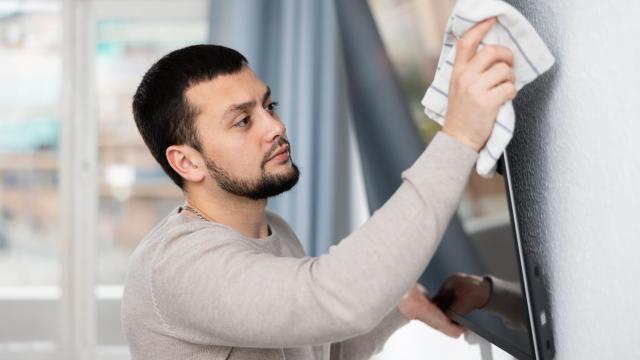The internet connectivity and delicate LCD screens of today’s TVs are a far cry from the sturdy boxes that once took up so much space in our living rooms. One thing those old bricks had going for them, though, was they were easy to clean without fear of damaging the whole machine. Plastic shells and glass screens could be wiped down pretty simply, while today’s TVs are more finicky and delicate, requiring some extra effort and care to clean.
You might still have one of those sturdy old TVs lurking around your place and, if so, you should know it’s called a CRTV or tube TV, and its screen can be cleaned with Windex (or another glass cleaner). Easy enough. You may also have a television that has a plasma screen — while those haven’t been manufactured for almost a decade, they’re still out there. If you have a newer television, it’s more than likely an LCD (LED) or OLED machine. The primary advice for cleaning these, per Consumer Reports, is to wipe down your screen with a soft, dry cloth — but there’s a little more to it than that.
Before you get started, turn off and unplug the TV. This will help it can cool down, which makes the process safer for the screen — and it’s easier to see smudges, streaks, and dirt. (And if you do need a little water for stubborn spots, you won’t risk mixing liquid and electricity.)
Check your owner’s manual to see if there are any cleaning instructions specific to the TV you own, too. If you didn’t hold onto that, check the manufacturer’s website, where you’ll typically find instructions. Your television may have even come with the type of cloth you need, so hopefully you held onto it, but if you didn’t, pick up a soft, microfiber one or use one made for glasses or cameras. Wipe in gentle circular motions.
Once you’ve wiped off most of the smudges off with your cloth, you may still need some extra effort for tougher spots. In this case, Consumer Reports suggests using a solution of very mild dish soap that is heavily diluted with water: Spray a bit on a cloth (never directly on the screen), rub it gently across any lingering grimy areas, and then wipe away any residual dampness with a dry microfiber cloth. (Or you could skip the dish soap entirely — a small amount of plain water sprayed onto the cloth should do the trick.) CR also reminds us that “LCD screens, in particular, are very sensitive to pressure and can scratch easily, so don’t press hard.” And never use glass cleaners or other harsh chemicals on these screens.
Finally, go after the vents. You can use a regular duster, or the soft brush attachment of your vacuum. Gently go over the vents on the back of the television to remove dust. (If the TV is freestanding, be sure to support it while you vacuum.) Finish off with a spritz of compressed air in the ports, then use your dry cloth to wipe off any dust that comes out.

Leave a Reply
You must be logged in to post a comment.